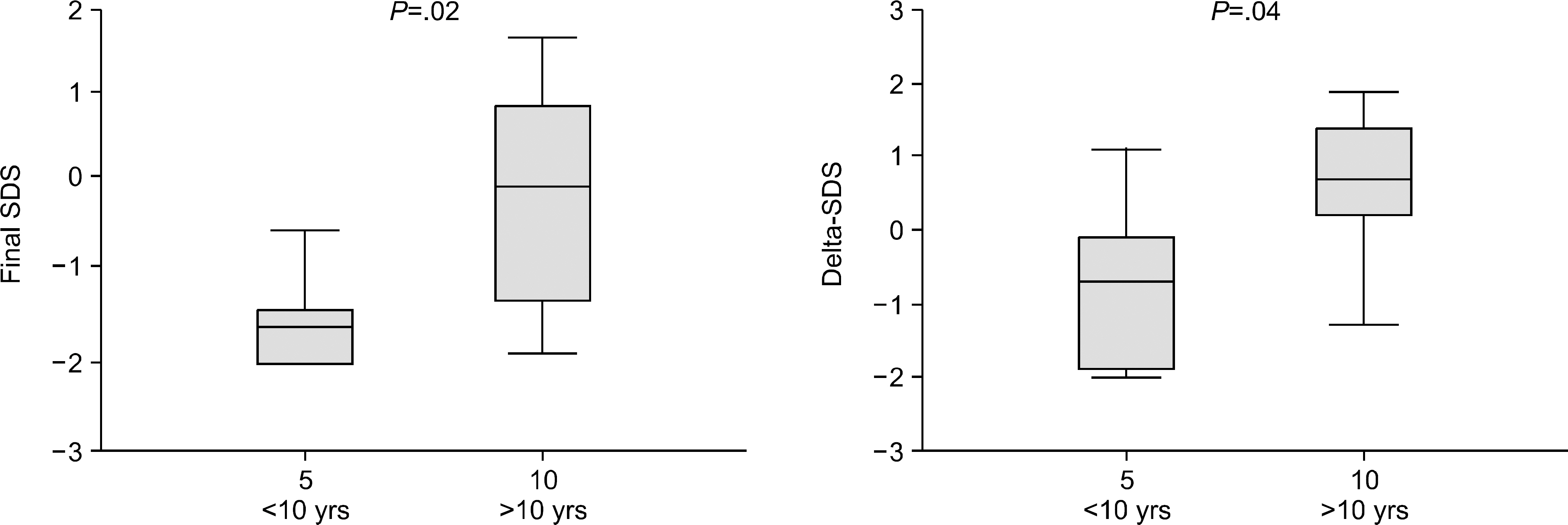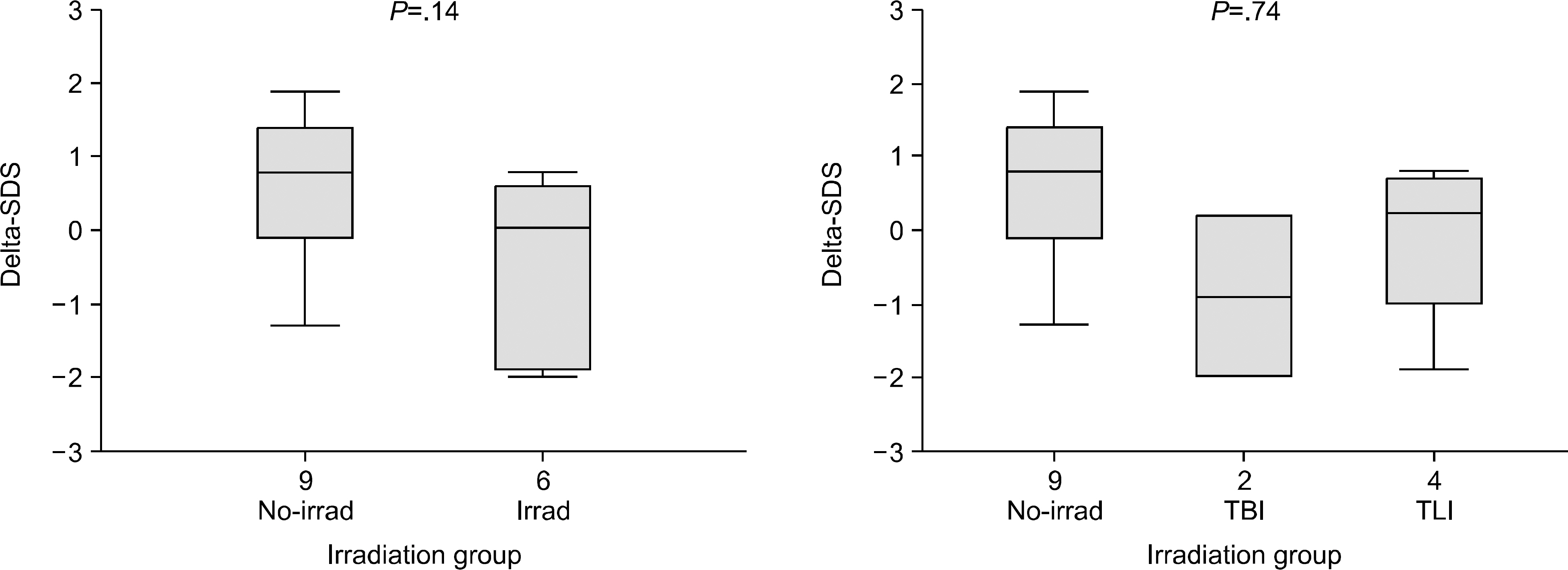Korean J Hematol.
2007 Dec;42(4):382-391. 10.5045/kjh.2007.42.4.382.
Final Height of Children after Stem Cell Transplantation
- Affiliations
-
- 1Blood and Marrow Transplantation Center, Department of Pediatrics, Chonnam National University Hwasun Hospital, Chonnam National University Medical School, Gwangju, Korea. hoonkook@chonnam.ac.kr
- KMID: 2252224
- DOI: http://doi.org/10.5045/kjh.2007.42.4.382
Abstract
-
BACKGROUND: Growth impairment is a common complication after hematopoietic stem cell transplantation (SCT). The aim of this study was to evaluate the final adult height of patients who underwent SCT in childhood and to identify the factors that influence long-term growth in these patients.
METHODS
A retrospective review of 15 children who underwent SCT before puberty at Chonnam National University Hospital and reached final adult height was undertaken. To assess the severity of height reduction and to monitor the height changes longitudinally, height measurements of each patient both at the time of SCT and the final height were expressed as the height standard deviation score (SDS).
RESULTS
Seven children were males and eight were females with a median age of 12.8+/-2.4 years (range, 6.3~14.7) at SCT. The median follow-up period was 7.1+/-2.0 years (range, 4.5~11.1) and their final height was achieved at 18.1+/-1.5 years (range, 17.0~21.8). Final height SDS values were within normal for the healthy population in all except two who had short stature (below -2.0 SDS). No patient achieved height values greater than +2.0 SDS. The final height SDS value (-0.5+/-1.2) was not decreased from the height SDS value at SCT (-0.8+/-0.8). The younger age group at SCT (6.1~10.0 years, n=5) showed significantly lower final height SDS and greater Delta SDS than the older age group (10.1~15.0 years, n=10) (-1.5+/- 0.6 vs. -0.1+/-1.1, P<.05; -1.2+/-0.7 vs. 0.5+/-0.8, P<.05, respectively). The irradiation-based conditioning (n=6) had negative effects on the Delta SDS (P>.05) and the final height SDS (P<.05). The gender, type of disease, donor type or the presence of chronic graft-versus-host disease did not influence height.
CONCLUSION
Growth impairment may be encountered in children after SCT. A younger age at transplant and irradiation were found to be factors associated with reduced final height. However, most patients (13/15) reached a final adult height within normal limits for the general healthy population.
MeSH Terms
Figure
Reference
-
1). Cohen A., Rovelli A., Bakker B, et al. Final height of patients who underwent bone marrow transplantation for hematological disorders during childhood: a study by the Working Party for Late Effects-EBMT. Blood. 1999. 93:4109–15.2). Korean Society of Pediatric Endocrinology. Growth. Pediatric endocrinology. 2nd ed.Korea: Kwangmun Press;2004. p. 36–56.3). Cohen A., Rovelli A., Van-Lint MT, et al. Final height of patients who underwent bone marrow transplantation during childhood. Arch Dis Child. 1996. 74:437–40.
Article4). Clement-De Boers A., Oostdijk W., Van Weel-Sipman MH., Van den Broeck J., Wit JM., Vossen JM. Final height and hormonal function after bone marrow transplantation in children. J Pediatr. 1996. 129:544–50.5). Huma Z., Boulad F., Black P., Heller G., Sklar C. Growth in children after bone marrow transplantation for acute leukemia. Blood. 1995. 86:819–24.
Article6). Bakker B., Massa GG., Oostdijk W., Weel-Sipman MH., Vossen JM., Wit JM. Pubertal development and growth after total-body irradiation and bone marrow transplantation for haematological malignancies. Eur J Pediatr. 2000. 159:31–7.
Article7). Bakker B., Oostdijk W., Geskus RB., Stokvis-Brantsma WH., Vossen JM., Wit JM. Patterns of growth and body proportions after total-body irradiation and hematopoietic stem cell transplantation during childhood. Pediatr Res. 2006. 59:259–64.
Article8). Sanders JE., Guthrie KA., Hoffmeister PA., Woolfrey AE., Carpenter PA., Appelbaum FR. Final adult height of patients who received hematopoietic cell transplantation in childhood. Blood. 2005. 105:1348–54.
Article9). Cohen A., van Lint MT., Uderzo C, et al. Growth in patients after allogeneic bone marrow transplantation for hematological diseases in childhood. Bone Marrow Transplant. 1995. 15:343–8.10). Tanner JM., Davis PS. Clinical longitudinal standards for height and height velocity for North American children. J Pediatr. 1985. 107:317–29.
Article11). Choi JM. 2005 Standards for growth for Korean child and adolescence. The 56th Korean Pediatric Annual Meeting Abstract Book; 2005 Apr 28-29; Yongpyung. Seoul: Korean Pediatric Society. 2005.12). Couto-Silva AC., Trivin C., Esperou H., Michon J., Fischer A., Brauner R. Changes in height, weight, and plasma leptin after bone marrow transplantation. Bone Marrow Transplant. 2000. 26:1205–10.
Article13). Holm K., Nysom K., Rasmussen MH, et al. Growth, growth hormone and final height after BMT. Possible recovery of irradiation-induced growth hormone insufficiency. Bone Marrow Transplant. 1996. 18:163–70.14). Shalet SM., Brennan BM. Growth and growth hormone status after a bone marrow transplantation. Horm Res. 2002. 58(Suppl 1):86–90.15). Shinagawa T., Tomita Y., Ishiguro H, et al. Final height and growth hormone secretion after bone marrow transplantation in children. Endocr J. 2001. 48:133–8.
Article16). Shalet SM., Brennan BM., Reddingius RE. Growth hormone therapy and malignancy. Horm Res. 1997. 48(Suppl 4):29–32.
Article17). Jenkins PJ., Mukherjee A., Shalet SM. Does growth hormone cause cancer? Clin Endocrinol. 2006. 64:115–21.
Article18). Leung W., Rose SR., Zhou Y, et al. Outcomes of growth hormone replacement therapy in survivors of childhood acute lymphoblastic leukemia. J Clin Oncol. 2002. 20:2959–64.
Article19). Katz JA., Pollock BH., Jacaruso D., Morad A. Final height attained in patients successfully treated for acute lymphoblastic leukemia. J Pediatr. 1993. 123:546–52.
- Full Text Links
- Actions
-
Cited
- CITED
-
- Close
- Share
- Similar articles
-
- Final Adult Height of Children with Normal Endocrine Function after Hematopoietic Stem Cell Transplantation
- Growth Patterns in Patients with Acute Leukemia after Allogeneic Stem Cell Transplantation
- Clinical utilization of cord blood over human health: experience of stem cell transplantation and cell therapy using cord blood in Korea
- Educational Needs of Families of Children Undergoing Hematopoietic Stem Cell Transplantation
- Opening the era of in vivo xenotransplantation model for hematopoietic stem cell transplantation




